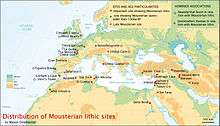Mousterian
 | |
| Geographical range | Afro-Eurasia |
|---|---|
| Period | Middle Paleolithic |
| Dates | 600,000 - 40,000 BP[1] |
| Type site | Le Moustier |
| Major sites | Creswell Crags, Lynford Quarry, Arcy-sur-Cure, Vindija Cave, Atapuerca Mountains, Zafarraya, Gorham's Cave, Devil's Tower |
| Preceded by | Micoquien, Clactonian |
| Followed by | Châtelperronian, Emireh culture, Aterian |
| The Paleolithic |
|---|
|
↑ Pliocene (before Homo) |
|
Lower Paleolithic
Middle Paleolithic
Upper Paleolithic
|
| ↓ Mesolithic ↓ Stone Age |
Mousterian is a name given by archaeologists to a style of predominantly flint tools (or industry) associated primarily with Neanderthals (Homo neanderthalensis) and dating to the Middle Paleolithic, the middle part of the European Old Stone Age.

Naming
The culture was named after the type site of Le Moustier, a rock shelter in the Dordogne region of France.[3] Similar flintwork has been found all over unglaciated Europe and also the Near East and North Africa. Handaxes, racloirs and points constitute the industry; sometimes a Levallois technique or another prepared-core technique was employed in making the flint flakes.[4]
Characteristics
Mousterian tools that have been found in Europe were made by Neanderthals and date from between 600,000 BP and 40,000 BP[1] Some assemblages, namely those from Pech de l’Aze, include exceptionally small points prepared using the Levallois technique among other prepared core types, causing some researchers to suggest that these flakes take advantage of greater grip strength possessed by Neanderthal physiology.[5] In North Africa and the Near East, Mouseterian tools were also produced by anatomically modern humans. In the Levant, for example, assemblages produced by Neanderthals are indistinguishable from those made by Qafzeh type modern humans.[6] It may be an example of acculturation of modern humans by Neanderthals because the culture after 130,000 years reached the Levant from Europe (the first Mousterian industry appears there 200,000 BP) and the modern Qafzeh type humans appear in the Levant another 100,000 years later.
Possible variants are Denticulate, Charentian (Ferrassie & Quina) named after the Charente region,[7] Typical and the Acheulean Tradition (MTA) - Type-A and Type-B.[8] The industry continued alongside the new Châtelperronian industry during the 45,000-40,000 BP period.[9]
Locations
- Mousterian artifacts have been located in sites in Northwest Africa.[10]
- Contained within a cave in the Syria region, along with a Neanderthaloid skeleton.[10]
- Located in the Haibak valley of Afghanistan.[10]
- Zagros and Central Iran
- The archaeological site of Atapuerca, Spain, contains Mousterian objects.
- Gorham's Cave in Gibraltar contains Mousterian objects.
- Uzbekistan has sites of Mousterian culture, including Teshik-Tash.[10]
- Turkmenistan also has Mousterian relics.[10]
-

A reconstruction of the head of the Shanidar 1 fossil, a Homo neanderthalensis male who lived circa 70000 BCE discovered in the mid-20th century at the Mousterian archaeological site Shanidar Cave
-

Range of Homo neanderthalensis
-

Restoration of Le Moustier Homo neanderthalensis by Charles R. Knight
-

According to the Toba catastrophe theory, the global human population sharply decreased to 3,000–10,000 surviving individuals circa 70000 BCE[1][2] It is estimated that the total Homo neanderthalensis population across Afro-Eurasia numbered at around 70,000 at its peak before the arrival of Homo sapiens[3]
-

Levallois points
-

Proximal Phalanges
- ^ Ambrose 1998; Rampino & Ambrose 2000, pp. 71, 80.
- ^ "Science & Nature - Horizon - Supervolcanoes". BBC.co.uk. Retrieved 2015-03-28.
- ^ O'Neill, Dennis. "Evolution of Modern Humans: Neanderthals", Palomar College, June 10, 2011, accessed August 21, 2011.
See also
- Neanderthal extinction hypotheses
- Synoptic table of the principal old world prehistoric cultures
- Levallois technique
References
- 1 2
- ↑ Currat, Mathias; Excoffier, Laurent (2004). "Modern Humans Did Not Admix with Neanderthals during Their Range Expansion into Europe". PLoS Biology 2 (12): e421. doi:10.1371/journal.pbio.0020421. PMC 532389. PMID 15562317.
- ↑ William A. Haviland; Harald E. L. Prins; Dana Walrath; Bunny McBride (24 February 2009). The Essence of Anthropology. Cengage Learning. p. 87. ISBN 978-0-495-59981-4. Retrieved 23 November 2011.
- ↑ Mark Aldenderfer; Alfred J. Andrea; Kevin McGeough; William E. Mierse; Carolyn Neel (29 April 2010). World History Encyclopedia. Abc-Clio. p. 330. ISBN 978-1-85109-929-0. Retrieved 23 November 2011.
- ↑ Dibble, Harold L.; McPherron, Shannon P. (October 2006). "The Missing Mousterian". Current Anthropology 47 (5): 777–803. doi:10.1086/506282.
- ↑ Shea, J. J., 2003: Neandertals [sic], competition and the origin of modern human behaviour in the Levant, Evolutionary Anthropology, 12:173-187.
- ↑ Andrew Lock, Charles R. Peters - Handbook of human symbolic evolution - 906 pages Oxford science publications Wiley-Blackwell, 1999 ISBN 0-631-21690-1 RETRIEVED 2012-01-06
- ↑ University of Oslo P.O. Box 1072 - Blindern-0316 Oslo-Norway email : fa-admin@admin.uio.no. / international@mn.uio.no - Universitetet i Oslo. Retrieved 2012-01-06
- ↑ http://www.nature.com/nature/journal/v512/n7514/full/nature13621.html
- 1 2 3 4 5 6 Langer, William L., ed. (1972). An Encyclopedia of World History (5th ed.). Boston, MA: Houghton Mifflin Company. p. 9. ISBN 0-395-13592-3.
External links
| Wikimedia Commons has media related to Mousterian. |
- Neanderthals’ Last Stand Is Traced — New York Times article (Published: September 13, 2006)
| Preceded by Micoquien |
Mousterian 600,000 years before present — 40,000 years before present |
Succeeded by Châtelperronian |
| |||||||||||||||||||||||||||||||||||||||||
| ||||||||||||||||||||||||||||||||||||||||||||||||||||||||||
